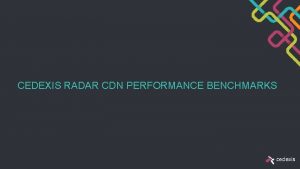Relative Network Positioning via CDN Redirections AoJan Su
















- Slides: 16

Relative Network Positioning via CDN Redirections Ao-Jan Su, David R. Choffnes, Fabián E. Bustamante and Aleksandar Kuzmanovic Department of EECS Northwestern University IEEE ICDCS 2008

Network Positioning Why do we need network positioning systems? – Emerging large scale distributed systems can benefit from selecting among alternative nodes • Example: select an on-line gaming server – All-to-all measurements are not scalable Current approaches – Provide network positioning services in a scalable way (e. g. landmark based) – Clear tradeoffs • Precision vs. overhead • Precision vs. deployment • And others Ao-Jan Su Relative Network Positioning via CDN Redirections 2

Observations Content distribution networks (e. g. , Akamai) improve web performance by – Performing extensive network measurements – Redirecting clients to their closest replica servers – Publishing the results through DNS Can we reuse those measurements collected by CDNs to build a network positioning system? Ao-Jan Su Relative Network Positioning via CDN Redirections 3

CDNs Basics Web client’s request redirected to ‘close’ by server – Client gets web site’s DNS CNAME entry with domain name in CDN network – Hierarchy of CDN’s DNS servers direct client to 2 nearby servers Hierarchy of CDN DNS servers Internet Customer DNS servers Multiple redirections to find nearby edge servers Web replica servers (3) (4) Client is given 2 nearby web (2) Client gets CNAME entryservers (fault replica tolerance) with domain name in Akamai Client requests translation for yahoo Ao-Jan Su LDNS (5) (6) (1) Relative Network Positioning via CDN Redirections Web client 4

Our approach CDN-based Relative Network Positioning (CRP) Clients are redirected to currently closest replica servers in general CDN’s redirections are primarily driven by network conditions (latency) [Su et al. 2006] Inferring relative network distance by overlapping CDN replica servers R 1 A Ao-Jan Su R 2 B Relative Network Positioning via CDN Redirections C 5

Uses of CRP Closest node selection – Select the closest node (shortest latency) from a group of candidates (e. g. select the closest on-line gaming server) – Methodology • Encode redirection frequency from a node to its redirected replica servers by a vector • Compare similarity (cosine similarity) of nodes’ redirection vectors to estimate proximity Replica servers R 1 Server A 0. 8 0. 2 Client Ao-Jan Su R 2 Server B R 3 Relative Network Positioning via CDN Redirections 6

Uses of CRP (Cont. ) Clustering – Select a set of nodes that are close to each other (e. g. replicate content to a group of nodes) – Methodology • Select cluster centers • Assign strong mapping peers to the cluster centers Ao-Jan Su Relative Network Positioning via CDN Redirections 7

Evaluation Goals Comparing the performance of CRP’s closest node selection to – Ground truth – active measurements – A state of the art network positioning system – Meridian [Wong 2005] With respect to – – Accuracy Scalability Deployment Overhead Meridian: Closest node selection Ao-Jan Su Relative Network Positioning via CDN Redirections 8

Experiment Setup Globally distributed nodes – 1000 DNS servers as clients – 240 Planet Lab nodes as candidate servers (on the same nodes as our reference system – Meridian) Concurrent data collection – Monitoring CDN redirections by recursive DNS queries for CRP – Querying Meridian via its interface – Measuring end-to-end latencies by pings as the ground truth Ao-Jan Su Relative Network Positioning via CDN Redirections 9

Selecting the closest node Clients are not close to any servers due to • Limited Planet Lab nodes coverage (Meridian) • Located in areas not well served by CDNs (CRP) CRP outperforms Meridian by 25% of the nodes due to larger deployment of CDN replica servers to its alternative CRP’s accuracy is comparable CRP’s recommendations for 65% of nodes differ frommeasurements Meridian by < 7 ms without active and dedicated infrastructure Ao-Jan Su Relative Network Positioning via CDN Redirections 10

Selecting the closest node (Cont. ) Relative Error: estimated latency – ground truth 80% of CRP nodes comparing have CRP’s is quite accurate to ground truth, relative error < 50 ms with virtually no measurement overhead Ao-Jan Su Relative Network Positioning via CDN Redirections 11

Load on CDN’s DNS System Rank: rank 0 is the closest server Low probe frequency • Smaller overhead • Less accurate • Miss overlapping replica servers 100 mins probe frequency High probe frequency • Appropriate for 95%Improve of nodes • Can accuracy • Much less than CDN’s DNS TTL (20 secs) • Larger overhead • Overhead is too small to impact CDN’s operations Ao-Jan Su Relative Network Positioning via CDN Redirections 12

Load on CRP Clients Small history Large history • More refined results • Larger computation overhead Ao-Jan Su • Sufficient for CRP • Small overhead • Capture network dynamics Relative Network Positioning via CDN Redirections 13

You May Be Wondering “Will CDNs be unhappy because of CRP? ” – CRP nodes behaves as regular web clients – CRP’s overhead does not impact CDN’s daily operations – Could be an additional service provided by CDNs “What if CDNs change their redirection policy? ” – CRP’s goal aligns with CDNs – Our approach is not restricted to a specific CDN, CRP can reuse results from other measurement infrastructures Ao-Jan Su Relative Network Positioning via CDN Redirections 14

Summary CRP discovers relative positions of end hosts – Closest node selection – Clustering Key features of CRP – Accurate – Light-weight • Reuse CDN’s network measurements – Scalable • No dedicated infrastructure is required Ao-Jan Su Relative Network Positioning via CDN Redirections 15

Cosine Similarity Ao-Jan Su Relative Network Positioning via CDN Redirections 16
 Decimo quinta estacion via crucis
Decimo quinta estacion via crucis Via negativa
Via negativa Estaciones via lucis
Estaciones via lucis Haz piramidal cruzado
Haz piramidal cruzado Palavras convergentes
Palavras convergentes Iptv cdn
Iptv cdn Azure cdn authentication
Azure cdn authentication Apache traffic server performance
Apache traffic server performance Cdn architectures
Cdn architectures What is cedexis radar
What is cedexis radar Akamai free
Akamai free Pixabay cdn
Pixabay cdn Https //fontawesome.bootstrapcheatsheets.com cdn
Https //fontawesome.bootstrapcheatsheets.com cdn 12112336 pix cdn org m p 0 83 83878 hevtgvi2 html
12112336 pix cdn org m p 0 83 83878 hevtgvi2 html Stage 15 relative clauses and relative pronouns
Stage 15 relative clauses and relative pronouns Conditional relative frequency distribution
Conditional relative frequency distribution Relative clauses jeopardy
Relative clauses jeopardy





























